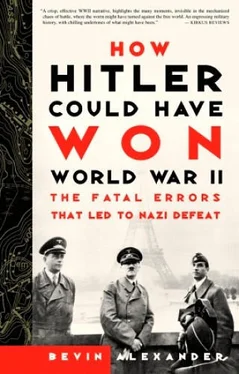p. 188: “attacks eastward, out of the mountains.” Bradley and Blair, 141.
p. 188: “could find to oppose it.” Omar Bradley agreed with Alexander, for he wrote that 2nd Corps “did not possess the force required for so ambitious a mission. Had we overextended ourselves from Gafsa to Gabès, we might have been seriously hurt on the flanks by an Axis counterattack.” He also wrote: “Alexander was right, 2nd Corps was not then ready in any respect to carry out operations beyond feints.” Bradley wrote that Patton and he accepted the corps’s limitation “with good grace.” However, a May 1943 German evaluation was much more complimentary. It said Americans had an ability to learn on the battlefield and would develop quickly into worthy opponents. See Bradley, 59–51; Bradley and Blair, 142; Liddell Hart, Second World War, 413, 415; Doubler, 28. Bradley’s timidity shows a dramatic contrast with Rommel. One could scarcely doubt what Rommel would have done if he’d had four times as many men as the enemy placed firmly on the enemy’s flank.
p. 189: “turn into a superb field commander.” Bradley and Blair, 98–101, 139; Bradley, 43–45; Blumenson, Patton, 12, 17.
Chapter 18: The Invasion of Sicily
p. 195: “cross-Channel invasion.” Kimball, 214.
p. 196: “commanders in the Mediterranean.” Churchill, Second World War, Hinge of Fate, 812–31.
p. 196: “‘the Messina bottleneck first.’” Bradley and Blair, 162–63.
p. 197: “‘an overwhelming victory.’” Ibid., 162; Liddell Hart, Second World War, 446.
p. 197: “the Allies invaded Sardinia.” Liddell Hart, Second World War, 437–38.
p. 199: “‘surrenders were frequent.’” Ibid., 442.
p. 200: “‘on that goddamn beach.’” Kimball, 226. Churchill went ahead with a British-only effort to seize the Dodecanese Islands. The Germans beat the British to the islands, and the British failed badly, losing 4,500 men, 21 warships, and 113 aircraft. See ibid., 226–27; Michael W. Parish, Aegean Adventures 1940–1943 and the End of Churchill’s Dream (Sussex, England: The Book Guild, 1993).
p. 201: “Badoglio announced surrender.” Liddell Hart, The Other Side of the Hill, 356–57.
p. 203: “delivered him from disgrace.” Blumenson, Patton, 209–18; Eisenhower, 179–83; Bradley, 160–62, 229; Bradley and Blair, 195–98, 201–2, 206–7, 218.
Chapter 19: The Citadel Disaster
p. 204: “and fighting troops.” Manstein, 443.
p. 204: “‘strongest fortress in the world.’” Mellenthin, 217.
p. 204: “mobilizing millions more.” Dahms, 439–40.
p. 205: “‘begging to be sliced off.’” Manstein, 445.
p. 205: “‘on the Black Sea.’” Ibid., 446.
p. 205: “they needed to prepare.” The original Tiger was a 56-ton machine mounting a high-velocity 88-millimeter cannon and 100 millimeters of armor, with a range of 87 miles. The 1944 model was several tons heavier with a slighter, longer range and shell-deflecting sloped sides on the turret like the Russian T-34. The Panther was first used in the Kursk battle. It was six tons lighter than the Tiger. It originally mounted an 88-millimeter gun, but later a 75-millimeter high-velocity cannon. Its range was 124 miles and it had 110-millimeter turret armor and 80-millimeter hull armor. Both were formidable weapons, and the Tiger was the best tank to come out of World War II.
p. 207: “‘my stomach turns over.’” Guderian, 306–9.
p. 207: “and 5,100 tanks.” Dahms, 442.
p. 208: “SS Panzer Corps.” The SS ( Schutzstaffel, or protective staff) began in 1925 as Hitler’s bodyguard, and under Heinrich Himmler expanded into many fields: intelligence ( Sicherheitsdienst or SD); concentration camp guards; police, including the Geheime Staatspolizei (Gestapo or secret police); rulers of occupied territories; and the Waffen-SS or armed SS, which totaled 50,000 men in 1939 and 910,000 in 39 divisions in autumn 1944. SS divisions and corps were integrated into the Wehrmacht chain of command, and were generally directed by senior army generals. The Waffen-SS originally required volunteers to be of racially “pure Aryan” stock, but this provision disappeared in the late stages of the war. Although Waffen-SS units developed into effective fighting organizations, they were responsible for many atrocities, and were known for routine brutality. See Zabecki, vol. 1, 759–63 (Jon Moulton); 782–84 (Samuel J. Doss).
p. 209: “losses were often heavy.” Mellenthin, 230–31. After Citadel, the Germans abandoned the Panzerkeil for the Panzerglocke, or tank bell. Superheavy tanks went to the center of the bell, medium tanks left and right, and light tanks behind ready for pursuit. The commander traveled behind the leading medium tanks, in radio contact with fighter-bombers, while engineers in armored vehicles just behind forward tanks were ready to clear gaps through minefields.
p. 209: “‘quail-shooting with cannons.’” Guderian, 311. At a demonstration on March 19, 1943, Guderian discovered the fatal flaw in Porsche’s Tigers, but since Hitler was enthusiastic, Guderian had to use them. At this same event, Hitler and Guderian saw new armor plate “aprons” for the Mark III and IV panzers. These aprons or skirts hung loose about the flanks and rear of the tanks to cause antitank shells to detonate prematurely and not penetrate the main tank armor. The innovation was highly effective, leading the Russians to produce larger, high-velocity antitank guns and main tank guns. The T-34 gun was raised from 76 millimeters to 85 millimeters. See ibid.; Glanz and House, 162. p. 212: “the size of its own.” Manstein, 457.
Chapter 20: The Assault on Italy
p. 214: “Rome into Allied hands.” Liddell Hart, Other Side of the Hill, 361–65.
p. 215: “forty self-propelled assault guns.” Mark Clark in his memoirs, Calculated Risk, wrote the Germans probably had “about six hundred tanks at Salerno.” See Clark, 199.
p. 218: “‘obtain tactical surprise.’” Linklater, 63.
p. 219: “ready to evacuate 6th Corps.” Cunningham, 569; Liddell Hart, Second World War, 463.
p. 221: “with John P. Lucas.” Eisenhower, 188.
p. 221: “obvious a place of landing.” Liddell Hart, Second World War, 469.
p. 223: “attacks on enemy positions.” Doubler, 13–21.
p. 225: “‘tactical move of my opponent.’” Liddell Hart, Other Side of the Hill, 364.
p. 227: “‘was a stranded whale.’” Churchill, Second World War, Closing the Ring. 488.
p. 228: “attack on Cassino had failed.” Ibid., 500.
p. 229: “‘hours of such terrific hammering.’” Ibid., 506.
p. 230: “‘have been disastrous.’” Ibid., 429.
p. 233: “‘once it had been recognized.’” Guderian, 328.
p. 233: “the other south of Paris.” An eleventh division, 19th Panzer, was in southern Holland and would not be used unless the Allies invaded the Low Countries.
p. 234: “‘at any other point.’” Guderian, 329.
p. 234: “‘handling large ships.’” Ibid., 331; Rommel, 453. Another factor pointed to the Pas de Calais: Hitler’s new revenge weapons, the V-1 unmanned jet bombers or cruise missiles, and the V-2 rocket-propelled ballistic missiles, were coming on line. The Allies were aware of them, and knew, because their range was limited, they had to be launched from around the Pas de Calais. The Germans believed the Allies would invade there to knock out the launch sites as quickly as possible.
Читать дальше


![Джонатан Димблби - Barbarossa - How Hitler Lost the War [calibre]](/books/385421/dzhonatan-dimblbi-barbarossa-how-hitler-lost-the-w-thumb.webp)









